Why? Factor analysis of risks (Slovic)
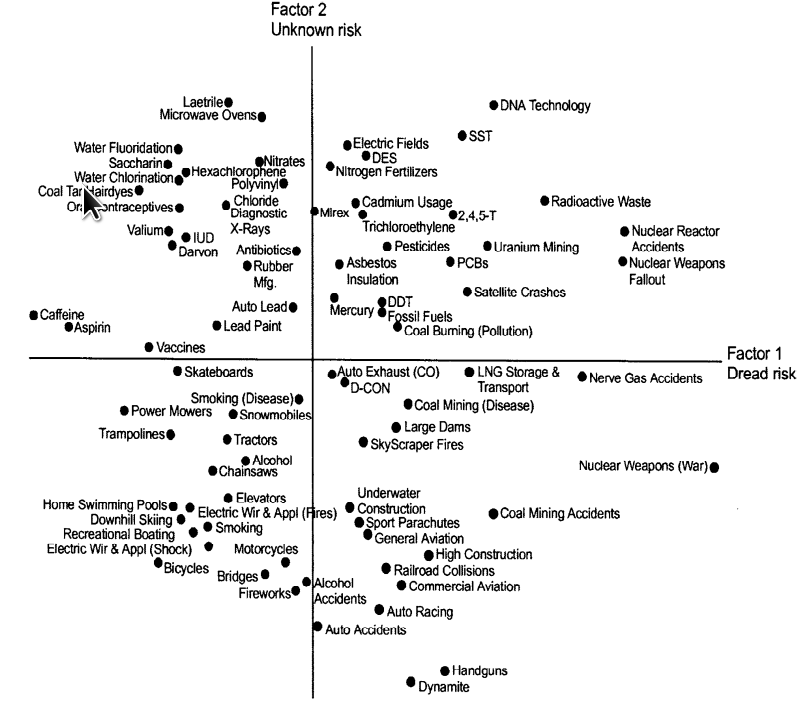
Activity Cause of death -------- -------------- Smoking 1.4 cigarettes Cancer, heart disease Drinking 1/2 liter of wine Cirrhosis of the liver Spending 1 hour in a coal mine Black lung disease Spending 3 hours in a coal mine Accident Living 2 days in New York or Boston Air pollution Travelling 6 minutes by canoe Accident Travelling 10 miles by bicycle Accident Travelling 150 miles by car Accident Flying 1,000 miles by jet Accident Flying 6,000 miles by jet Cancer caused by cosmic radiation
INTERVENTION COST PER LIFE-YEAR Mandatory seat-belt-use law $69 Influenza vaccination for all citizens $140 Sickle-cell screening for black newborns $240 Federal law requiring smoke detectors in homes $920 Mandatory motorcycle-helmet laws $2,000 Pneumonia vaccination for seniors $2,200 Chlorination of drinking water $3,100 Smoking-cessation advice for people who smoke more than one pack per day $9,800 Alcohol-safety programs for drunk drivers $21,000 AZT for people with AIDS $26,000 Smoke detectors in airplane lavatories $30,000 Child-resistant cigarette lighters $42,000
Ban asbestos in pipeline wrap $65,000 Child-restraint systems in cars $73,000 Promote voluntary helmet use for all-terrain vehicles $44,000 National 55 mph speed limit $89,000 Community health-care services for women and infants $100,000 Widen lanes on rural roads from 9 to 11 feet $150,000 Pneumonia vaccination for children age 2Ä4 $170,000 Redesign chain saws to reduce rotational kickback injuries $230,000 Ban amitraz pesticide on pears $350,000 Ozone-control program for southern coast of California $610,000
Warning letters sent to problem drivers $720,000 Ejection system for the Air Force B-58 bomber $1,200,000 Triple the wind-resistance capabilities of new buildings $2,600,000 Seat belts for school-bus passengers $2,800,000 Ban asbestos in packing $5,700,000 Strengthen buildings in earthquake-prone areas $18,000,000From "Five-Hundred Life-Saving Interventions and Their Cost-Effectiveness," a study conducted by Tammy 0. Tengs, et al., and published in Risk Analysis, Vol. 15, No. 3.

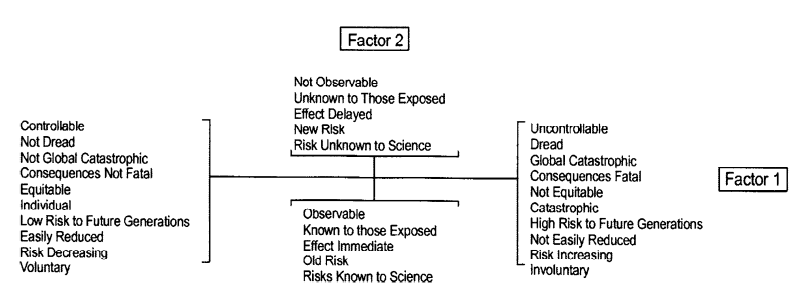
| Mean WTP | U.S. deaths | Implied U.S. | Actual or proposed | |
| Hazard | in survey | per year | national WTP | expenditures |
| Workplace chemical | $7.95 | 1 | $715 mil. | > $11 mil. |
| Explosives | $7.68 | 2 | $345 mil. | $3 mil. |
| Aviation | $46.07 | 40 | $103 mil. | $680,000 |
| Power tools | $15.05 | 80 | $17 mil. | $430,000 |
| Automobiles | $161.30 | 10,000 | $1.3 mil. | $95,000 |
"There is a distinction between an individual life and a statistical life. Let a 6-year-old girl with brown hair need thousands of dollars for an operation that will prolong her life until Christmas, and the post office will be swamped with nickels and dimes to save her. But let it be reported that without a sales tax the hospital facilities of Massachusetts will deteriorate and cause a barely perceptible increase in preventable deaths - not many will drop a tear or reach for their checkbooks." (Schelling, 1968)
1. Partially clean up both landfills. The number of cancer cases would be reduced from 8 to 4 cases in the larger city and from 4 to 2 cases in the smaller city.
2 Totally clean up the landfill in the smaller city and partially clean up the landfill in the larger city. The number of cancer cases would be reduced from 8 to 7 cases in the larger city and from 4 to 0 cases in the smaller city.
3. Concentrate on the landfill in the larger city, but partially clean up the landfill in the smaller city. The number of cancer cases would be reduced to from 8 to 3 cases in the larger city and from 4 to 3 cases in the smaller city.
Viscusi et al.: smokers in Spain:
Worry has independent effects (Baron et al.)
Seat-belt example
Rottenstreich and Hsee (2001):
$7 (median) to avoid a 1% chance of a shock
$10 to avoid a 99% chance
People don't ask for information
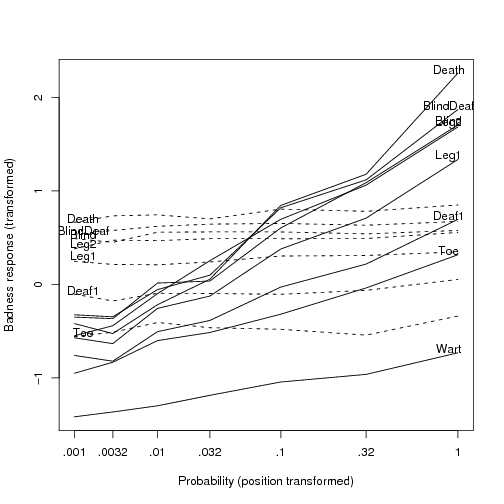
35% of the public agreed that, ``For pesticides, it's not how much of the chemical you are exposed to that should worry you, but whether or not you are exposed to it at all.'' Only 4% of the scientists agreed. (Kraus et al.)
20% agreed that, ``If something can cause harm to the body in large amounts, then it is always better not to eat it even in small amounts'' (Rozin et al., 1996).
26% agreed that a diet free of salt is healthier than the same diet with a pinch of salt.
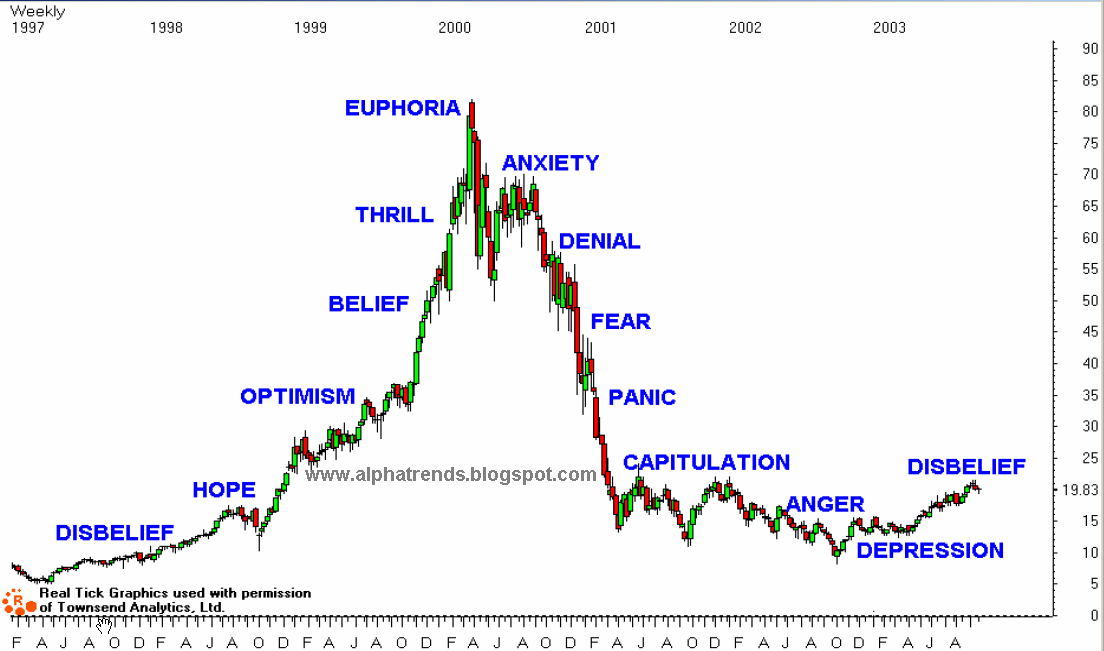
People think too short:
* Won't pay x for (3.5x,.33), but they will if they decide on a group of 3
(Gneezy and Potters, 1997).
But they are overconfident starting new businesses (Camerer and Lovallo, 1999):
* Competitive game, chance or skill (puzzles).
* Made more money when chance.
* More confident when skill.
Redistribution: declining marginal utility
low deductables (and then don't file claims): e.g., people pay $100 to reduce deductable from $1000 to $500, with 5% claim rate (Snydor, 2006)
failure to use subsidy (flood): possibly the result of reducing low probabilities to zero
ambiguity
Vividness (Johnson et al., 1993):
$14.12 for insurance against death from ``any act of terrorism,''
$10.31 for death from ``any non-terrorism related mechanical failure,''
$12.03 for death from ``any reason.''
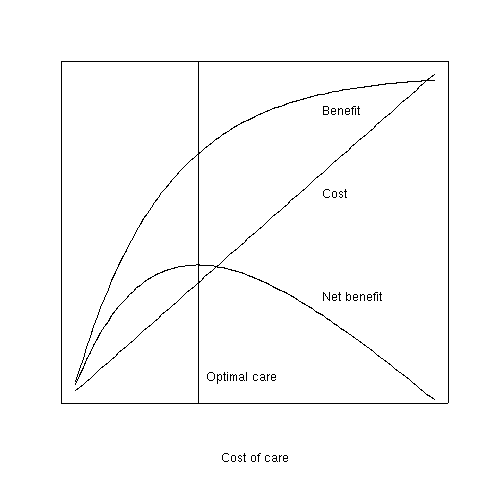
retribution, not deterrence
confusion of compensation and deterrent functions
It matters if people cause it.
Subjects in one study were willing to contribute about $19 to an international fund to save Mediterranean dolphins when the dolphins were "threatened by pollution" but only $6 when the dolphins were "threatened by a new virus." (Kahneman et al., 1993; Kahneman and Ritov, 1994).
In another study, subjects thought that compensation for injuries such as infertility should be greater when the injury is caused by a drug rather a natural disease, even if the penalty paid by the drug maker does not affect the amount of compensation paid to the victim (Baron and Ritov, 1993).
Subjects preferred to have companies clean up their own hazardous waste, even if the waste threatened no one, rather than spend the same amount of money cleaning up the much more dangerous waste of a defunct company (Baron, Gowda, and Kunreuther, 1993).
Beattie and Baron (1995) found that people prefer in-kind penalties over out-of-kind penalties.
For example, if a company caused a fire that destroyed a forest (beach), subjects would rather have the company pay for the planting of a new forest (preservation of a beach) than for preservation of a beach (planting of a new forest). The forest was to be planted anyway.
Own-group bias.
Self-interest illusion: "I am a member of my group. So anything that helps my group helps me. Thus, if I sacrifice for my group, I help myself."
Would cause oppoisition to alternative ways of helping.
Global warming may be more "available" than some of the alternative problems, such as overfishing or flu.
Concerns for risk risk and fall in cycles that sometimes have little to do with evidence (Loewenstein \& Mather, 1990).
Smart government, trust (Breyer, Sunstein)
Libertarian paternalism (Sunstein and Thaler)
Education
Information
"He who refuses to do arithmetic is doomed to talk nonsense." John McCarthy